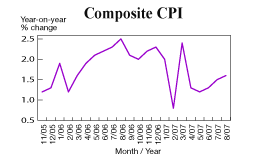
|
Moderate increase: Overall consumer prices in August rose 1.6% over a year earlier. |
Overall consumer prices in August rose 1.6% over the same month last year, the Census & Statistics Department says. The rise was mainly due to the year-on-year increase in food prices, from 3.6% in July to 4.6% in August.
The cut in Housing Authority rents partly offset the impact of the higher food prices.
The rates concession for April to September carried on this effect to the CPI in August. Netting out this factor, the year-on-year rise in the Composite CPI was 2.7%.
A larger year-on-year price increase was recorded for food (excluding meals bought away from home) (up 7.8%). Food items showing large price increases were pork (31.4%), eggs (27.9%), canned meat (20.7%), beef (15.8%), frozen meat (14.9%), poultry (12.1%), other meat (12.1%), rice (11.7%), edible oils (10.4%) and saltwater fish (10.2%).
Year-on-year price falls were recorded for fresh vegetables (-2.9%), cereals and cereal preparations (other than rice) (-0.9%) and carbonated drinks (-0.4%). Most other food items registered price increases of 5% or less.
Apart from food (excluding meals bought away from home), year-on-year increases in prices were recorded for clothing and footwear (4.3%), meals bought away from home (2.7%), miscellaneous goods (2%) and miscellaneous services (1.7%).
Year-on-year declines in prices were recorded for durable goods (-4.1%) and electricity, gas and water (-2.4%).
As for housing, the Composite CPI rose only 0.4% over a year earlier, a result of the rates concession and public housing rental cut.
Taking the first eight months of 2007 together, the Composite CPI rose 1.5% over a year earlier.
Noting the higher rate of increase in the Composite CPI in August was mainly caused by price increases for a broad range of basic food items as well as in the charges for meals bought away from home, the department said the underlying inflation rate at 2.7% was still rather moderate.
Looking ahead, higher food prices will continue to pose an upside risk to inflation. With the favourable effect of the rates concession fading out after September, the headline inflation rate is expected to edge higher in the fourth quarter. Nevertheless, the recent cut in public housing rentals and sustained labour productivity growth will provide some cushioning effect.
|